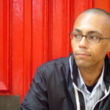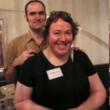White is for witching
Description
“Miranda is at home—homesick, home sick ...”As a child, Miranda Silver developed pica, a rare eating disorder that causes its victims to consume nonedible substances. The death of her mother when Miranda is sixteen exacerbates her condition; nothing, however, satisfies a strange hunger passed down through the women in her family. And then there’s the family house in Dover, England, converted to a bed-and-breakfast by Miranda’s father. Dover has long been known for its hostility toward outsiders. But the Silver House manifests a more conscious malice toward strangers, dispatching those visitors it despises. Enraged by the constant stream of foreign staff and guests, the house finally unleashes its most destructive power.With distinct originality and grace, and an extraordinary gift for making the fantastic believable, Helen Oyeyemi spins the politics of family and nation into a riveting and unforgettable mystery.
More Details
9781594633072
159463307
9780385530330
Excerpt
Similar Titles From NoveList
Similar Authors From NoveList
Published Reviews
Booklist Review
Oyeyemi's third mystical novel weaves a tale of four generations of women and the house in Dover, England, they've inhabited a vengeful, Gothic edifice that has always rejected strangers. The latest occupants are twins Miranda and Eliot, who were 16 when their mother, Lily, died and when their father, Luc, converted the house into a B&B. Miranda's grief is far far bigger than her. She develops pica, an eating disorder, eschewing her father's cooking and binging on hidden caches of chalk and plastic. After Miranda is discharged from a clinic, Eliot grapples with his brotherly responsibilities, telling Lily's ghost, She won't forget or recover, she is inconsolable. Lily's mentally ill mother and grandmother still inhabit the house each understanding that we absolutely cannot have anyone else. Oyeyemi's style is as engimatic as her plot, with juxtaposition of past and present and abrupt changes in narrator, from third to first person, Eliot to Miranda, Lily to her mother. In all, a challenging read laced with thought-provoking story lines that end, like Miranda's fate, mysteriously.--Donovan, Deborah Copyright 2009 Booklist
Publisher's Weekly Review
Oyeyemi delivers her third passionate and unusual book, a neo-gothic tale revolving around Miranda and Eliot Silver, fraternal twins of Haitian descent raised in a British house haunted by generations of afflicted, displaced family members, including their mother. Miranda suffers from pica, an affliction that causes her to eat nonedible items, which is passed down to her via the specters from her childhood that now punctuate her nightmares. As the novel progresses, the increasingly violent nature of this bizarre, insatiable hunger reveals itself to be the ironclad grip of the dead over the living or of mother over daughter. The book is structured around multiple voices-including that of the house itself-that bleed into one another. Appealing from page one, the story, like the house, becomes extremely foreboding, as the house is "storing its collapse" and "can only be as good as" those who inhabit it. The house's protective, selfish voice carries a child's vision of loss: in the absence of a mother, feelings of anger, betrayal and bodily desire replace the sensation of connection. Unconventional, intoxicating and deeply disquieting. (June) (c) Copyright PWxyz, LLC. All rights reserved
Library Journal Review
After Lily Silver is killed on assignment in Haiti, her family is left in her childhood home in Dover, England. While her widower, Luc, throws himself into the running of his bed-and-breakfast, their son, Eliot, stays away from home as much as he can, and their daughter, Miranda, begins to lose herself in her eating disorder. After Miranda returns from a psychiatric clinic, the Silver House begins to haunt her with visions of her mother, grandmother, and great-grandmother, keeping her close while driving away foreign guests. The house also drives away Miranda's African friend from Cambridge, and Miranda herself disappears into the secret passages of the house. VERDICT Oyeyemi's third novel (after The Opposite House) is eerie and compelling, employing a nonlinear style that features wisps of family history and various unreliable narrators breaking into the text that suit a gothic, ghostly story. Readers who like paranormal tales and family secrets, told in an experimental style, will enjoy this novel.--Amy Ford, St. Mary's Cty. Lib., Lexington Park, MD (c) Copyright 2010. Library Journals LLC, a wholly owned subsidiary of Media Source, Inc. No redistribution permitted.
Booklist Reviews
Oyeyemi's third mystical novel weaves a tale of four generations of women and the house in Dover, England, they've inhabited—a vengeful, Gothic edifice that has always rejected strangers. The latest occupants are twins Miranda and Eliot, who were 16 when their mother, Lily, died and when their father, Luc, converted the house into a B&B. Miranda's grief is "far far bigger than her." She develops pica, an eating disorder, eschewing her father's cooking and binging on hidden caches of chalk and plastic. After Miranda is discharged from a clinic, Eliot grapples with his brotherly responsibilities, telling Lily's ghost, "She won't forget or recover, she is inconsolable." Lily's mentally ill mother and grandmother still "inhabit" the house—each understanding that "we absolutely cannot have anyone else." Oyeyemi's style is as engimatic as her plot, with juxtaposition of past and present and abrupt changes in narrator, from third to first person, Eliot to Miranda, Lily to her mother. In all, a challenging read laced with thought-provoking story lines that end, like Miranda's fate, mysteriously. Copyright 2009 Booklist Reviews.
Library Journal Reviews
After Lily Silver is killed on assignment in Haiti, her family is left in her childhood home in Dover, England. While her widower, Luc, throws himself into the running of his bed-and-breakfast, their son, Eliot, stays away from home as much as he can, and their daughter, Miranda, begins to lose herself in her eating disorder. After Miranda returns from a psychiatric clinic, the Silver House begins to haunt her with visions of her mother, grandmother, and great-grandmother, keeping her close while driving away foreign guests. The house also drives away Miranda's African friend from Cambridge, and Miranda herself disappears into the secret passages of the house. VERDICT Oyeyemi's third novel (after The Opposite House) is eerie and compelling, employing a nonlinear style that features wisps of family history and various unreliable narrators breaking into the text that suit a gothic, ghostly story. Readers who like paranormal tales and family secrets, told in an experimental style, will enjoy this novel.—Amy Ford, St. Mary's Cty. Lib., Lexington Park, MD
[Page 64]. Copyright 2008 Reed Business Information.Publishers Weekly Reviews
Oyeyemi delivers her third passionate and unusual book, a neo-gothic tale revolving around Miranda and Eliot Silver, fraternal twins of Haitian descent raised in a British house haunted by generations of afflicted, displaced family members, including their mother. Miranda suffers from pica, an affliction that causes her to eat nonedible items, which is passed down to her via the specters from her childhood that now punctuate her nightmares. As the novel progresses, the increasingly violent nature of this bizarre, insatiable hunger reveals itself to be the ironclad grip of the dead over the living or of mother over daughter. The book is structured around multiple voices—including that of the house itself—that bleed into one another. Appealing from page one, the story, like the house, becomes extremely foreboding, as the house is "storing its collapse" and "can only be as good as" those who inhabit it. The house's protective, selfish voice carries a child's vision of loss: in the absence of a mother, feelings of anger, betrayal and bodily desire replace the sensation of connection. Unconventional, intoxicating and deeply disquieting. (June)
[Page 103]. Copyright 2008 Reed Business Information.






























